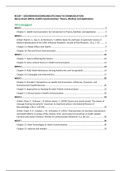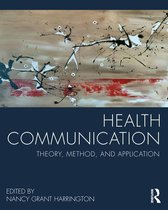RECAP – GEZONDHEIDSCOMMUNICATIE/HEALTH COMMUNICATION
Nancy Grant (2015), Health Communication: Theory, Method, and Application.
Inhoudsopgave
WEEK 1 ........................................................................................................................................ 2
Chapter 1: Health Communication: An Introduction to Theory, Method, and Application ............... 2
WEEK 2 ........................................................................................................................................ 3
Artikel: Klemm, C., Das, E., & Hartmann, T. (2016). Swine flu and hype: A systematic review of
Media Dramatization of the H1N1 Influenza Pandemic. Journal of Risk Research, 19, p. 1-20 ......... 3
Chapter 13: Media Effects and Health ................................................................................................ 4
Chapter 16: Risk and Crisis Communication........................................................................................ 6
WEEK 3 ...................................................................................................................................... 10
Chapter 7: Factors Affecting the Patient ........................................................................................... 10
Chapter 8: Socio-cultural Factors in Health Communication ............................................................ 12
WEEK 4 ...................................................................................................................................... 14
Chapter 9: Risky Health Behaviours Among Adolescents and Young Adults .................................... 14
Chapter 14: Campaigns and Interventions ........................................................................................ 17
WEEK 5 ...................................................................................................................................... 20
Chapter 4: Providers’ Perspectives on Health Communication: Influences, Processes, and
Outcomes (t/m health literacy) ......................................................................................................... 20
Chapter 5: Approaches to Studying Provider-Patient Communication ............................................ 22
Chapter 11: Ethical Issues in Health Communication ....................................................................... 26
WEEK 6 ...................................................................................................................................... 29
Artikel: Glare, P., Fridman, I. & Ashton-James, C. (2018) Choose your words wisely: The impact of
message framing on patients’ responses to treatment advice. International Review of
Neurobiology, 139, p. 159-190. ......................................................................................................... 29
Artikel: Graaf, A. D., Sanders, J. M., & Hoeken, H. (2016). Characteristics of narrative interventions
and health effects: A review of the content, form, and context of narratives in health-related
narrative persuasion research. Review of Communication Research, 4, p. 88-131 ......................... 30
WEEK 7 ...................................................................................................................................... 30
Chapter 12: New Technologies in Heath Communication ................................................................ 30
Chapter 15: Internet and eHealth ..................................................................................................... 33
, WEEK 1
Chapter 1: Health Communication: An Introduction to Theory, Method, and Application
WHAT IS HEALTH COMMUNICATION ANYWAY?
There are a lot of definitions of health communication. The definition mentioned and worked with in
this book is: “Health communication is the study of messages that create meaning in relation to
physical, mental, and social well- being.”
THE NATURE OF HEALTH COMMUNICATION RESEARCH
Health communication research is multidisciplinary, interdisciplinary, and transdisciplinary. Research
can be conducted from scientific, interpretive, or critical–cultural paradigmatic perspectives.
Research results can be translated to have positive impact on the health and well- being of society.
- Multidisciplinary research in health communication involves researchers from multiple
disciplines independently investigating the communication dimension of a health problem. In
doing so, they bring multiple perspectives on the same health question.
- Interdisciplinary research involves researchers from multiple disciplines collaboratively
investigating multiple dimensions of either a health problem in general or the
communication aspect of a health problem. The difference with multidisciplinary research is
that here they’re doing so in teams whose members bring different types of expertise to the
problem and who can learn from one another to more fully inform the problem.
- Translational research is the process of applying knowledge from basic biology and clinical
trials to techniques and tools that address critical medical needs. Unlike applied
sciences, translational research is specifically designed to improve health outcomes.
- Transdisciplinary research is research that spans disciplinary boundaries to create new
theories and methods that integrate knowledge from multiple disciplines to address complex
social problems.
Basic research is designed to test and redefine theoretical models, whereas applied research is
designed to solve a problem. Both are important to health communication, and they need not be
mutually exclusive. In fact, in cases of programmatic research, researchers often begin with basic
research and build toward applied research.
THEORY, METHOD, AND METATHEORY (HANG IN THERE, GUYS. IT’S OKAY!)
Theory plays an important role in research, and let’s be familiar with a basic definition: theory is an
organized set of concepts and explanations about a phenomenon.
Methods are simply the strategies researchers use to study the phenomena of interest:
- Quantitative methods require data in numerical form so that the data can be analysed
through statistical techniques → usually involves making generalizations about groups of
people or phenomena.
- Qualitative methods require data that allow for in- depth analysis of the socially constructed
meaning of language and behaviour → usually involves developing a rich understanding of
particular experiences.
➔ Let me be clear: The “best” method isn’t quantitative or qualitative; it’s the one that ¿ ts your
research question, pure and simple.
Metatheory encompasses a paradigmatic perspective, or a way of “looking at the world.” It makes
assumptions about the nature of reality (ontology), the nature of knowledge (epistemology), and the
role of values in research (axiology). These assumptions matter because they influence the way you
do your research.
2





